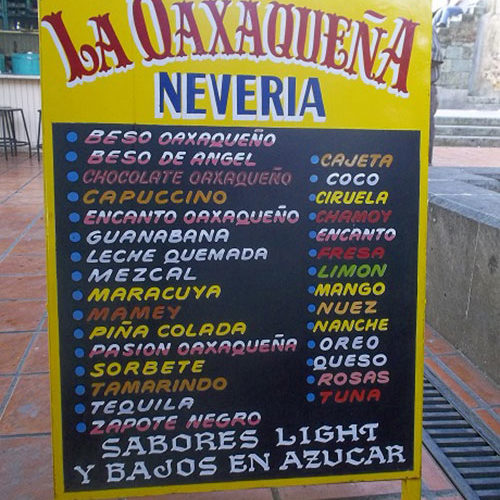This is one of the most famous and characteristic of the Oaxacan nieves. Actually it has two versions, one more distinctively Oaxacan than the other but also harder to approximate here. To add to the confusion, in other parts of Mexico the term leche quemada refers to a rich caramel made by cooking down milk and sugar together to an intensely flavored syrup (it also goes by the name cajeta). Neither of the Oaxacan nieves exactly matches this. In the simpler one, the sugar is caramelized and then briefly cooked with the milk before being combined with a custard mixture. In the other, the milk is actually burnt — put in a saucepan over high enough heat to actually scorch the bottom. (I was unable to achieve this with U.S. pasteurized milk without it boiling over.) The scorched flavor is communicated to the whole dish — another example of the Oaxacan fondness for burnt flavors that shows up in some moles and other savory dishes.
In Oaxaca City nieve de leche quemada is always served with a dollop of crimson preserves from the cactus fruit called jiotilla (Escontria chiotilla). The tart flavor is a wonderfully refreshing contrast to the sweetness of the ice cream. If desired, try a substitute such as a spoonful of tart strawberry or raspberry preserves.

Burnt Milk Ice Cream (Nieve de leche quemada)
Ingredients
- 1 quart whole milk divided
- 1⅓ cups granulated sugar
- 4 large egg yolks
- One 3-inch piece
canela
Instructions
- In a small saucepan, heat 2 cups of milk over medium heat until just boiling. Remove before it boils over and keep warm over a Flame-Tamer or other heat diffusing device while you caramelize the sugar.
- Put ⅔ cup of the sugar into a small, heavy saucepan and heat over medium-low heat. At first nothing will happen, then the sugar will rapidly darken and liquefy. At once — while it is still medium-light rather than dark brown — pour in a little of the boiled milk, stirring rapidly to start dissolving the sugar. Watch out — it will splatter up furiously at first. Quickly add the rest of the boiled milk and cook, stirring, over low heat until the caramelized sugar is completely dissolved and the milk pale brown, about 5 minutes. Keep warm while you make the custard.
- In a mixing bowl, lightly whisk the egg yolks and add the remaining 2 cups milk, and ⅔ cup sugar. Whisk or stir to combine well and dissolve the sugar without creating too much froth. (Alternatively, process the egg yolks, milk, and sugar together in a blender for 20-30 seconds.) Pour the mixture into a medium-size saucepan and place over very low heat or for still gentler cooking with less danger of curdling use a double boiler top set over simmering water. Stirring constantly with a wooden spoon, 3-5 minutes (or a little longer in a double boiler). Be careful — too high heat or long cooking will curdle the mixture. Add the caramelized sugar mixture and stir to combine smoothly with the custard. Remove from the heat and let cool completely.
- Freeze by manufacturer’s directions for your ice cream maker. Or still-freeze by placing in a 1½-quart container (preferably stainless steel) and freezing as directed for Nieve de tamarindo, i.e., beating with chilled beaters after 2 hours’ freezing, beating again after an additional 1 hour’s freezing, and returning to the freezer until serving time.

